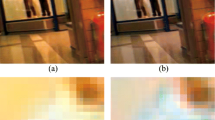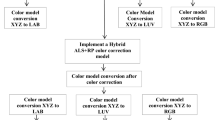Abstract
Most color constancy algorithms implement a color correction process that performs globally for the entire input pixel image. This process leads to a saturation problem and overcorrected images, especially in overexposed regions, thereby resulting in contrast inconsistency and incorrect true-color image objects. Each pixel in an input image should have a different correction range value. Pixels with high probability to be saturated or overcorrected should not be treated similarly as pixels with low probability. Thus, this study proposes a new color correction algorithm that aims to reduce the effects of the saturation phenomenon and overcorrected color images while enhancing the image contrast. To achieve this objective, the proposed algorithm consists of two main processes, namely, color correction and contrast enhancement. A shifting process is nonlinearly applied to each pixel in a 2D two-channel CIELAB color space. Each pixel has a different corrected rate depending on the adaptive limit value and the reference point. Subsequently, the global and local contrast corrections are executed on the L channel to enhance the image contrast. Qualitative and quantitative results on 653 outdoor; 818 indoor; and 1394 underwater images show that the proposed algorithm outperforms several state-of-the-art algorithms in producing enhanced color constancy and contrast. The proposed algorithm also reduces noise effects and improves the details of an image without creating unnatural and inaccurate color constancy.














Similar content being viewed by others
References
Agaian SS, Panetta KP, Grigoryan AM (2000) A new measure of image enhancement. Proc Int Conf Signal Process pp 19–22. Retrieved from http://citeseerx.ist.psu.edu/viewdoc/download? Accessed 15 September 2017
Agaian SS, Silver B, Panetta KA (2007) Transform coefficient histogram-based image enhancement algorithms using contrast entropy. IEEE Trans Image Process 16:741–758. https://doi.org/10.1109/TIP.2006.888338
Agarwal V, Gribok AV, Abidi MA (2007) Machine learning approach to color constancy. Neural Netw 20:559–563. https://doi.org/10.1016/j.neunet.2007.02.004
Bai XD, Cao ZG, Wang Y, Yu ZH, Zhang XF, Li CN (2013) Crop segmentation from images by morphology modeling in the CIE L*a*b* color space. Comput Electron Agric 99:21–34. https://doi.org/10.1016/j.compag.2013.08.022
Banić N, Lončarić S (2017) Unsupervised Learning for Color Constancy. Proc 13th Int Jt Conf Comput Vision, Imaging Comput Graph Theory Appl 4:181–188. https://doi.org/10.5220/0006621801810188.
Barnard K, Cardei V, Funt B (2002) A comparison of computational color constancy algorithms - Part I: Methodology and experiments with synthesized data. IEEE Trans Image Process 11:972–984. https://doi.org/10.1109/TIP.2002.802531
Barnard K, Martin L, Coath A, Funt BV (2002) A comparison of computational color constancy algorithms--part II: experiments with image data. IEEE Trans Image Process 11:985–996. https://doi.org/10.1109/TIP.2002.802529
Barnard K, Martin L, Funt B, Coath A (2002) A data set for color research. Color Res Appl 27:147–151. https://doi.org/10.1002/col.10049
Bianco S, Ciocca G, Cusano C, Schettini R (2008) Classification-based color constancy, In: Vis. Inf. Syst. Web-Based Vis. Inf. Search Manag., Springer Berlin Heidelberg, pp. 104–113. https://doi.org/10.1007/978-3-540-85891-1_14
Bianco S, Ciocca G, Cusano C, Schettini R (2010) Automatic color constancy algorithm selection and combination. Pattern Recogn 43:695–705. https://doi.org/10.1016/j.patcog.2009.08.007
Bianco S, Cusano C, Schettini R (2015) Color constancy using CNNs. IEEE Comput Soc Conf Comput Vis Pattern Recognit Work:81–89. https://doi.org/10.1109/CVPRW.2015.7301275
Buchsbaum G (1980) A spatial processor model for object colour perception. J Frankl Inst 310:1–26. https://doi.org/10.1016/0016-0032(80)90058-7.
Cardei VC, Funt B, Barnard K (2002) Estimating the scene illumination chromaticity by using a neural network. J Opt Soc Am A 19:2374–2386
Cepeda-Negrete J, Sanchez-Yanez RE (2015) Automatic selection of color constancy algorithms for dark image enhancement by fuzzy rule-based reasoning. Appl Soft Comput J 28:1–10. https://doi.org/10.1016/j.asoc.2014.11.034
Faghih MM, Moghaddam ME (2014) Multi-objective optimization based color constancy. Appl Soft Comput J 17:52–66. https://doi.org/10.1016/j.asoc.2013.11.016
Finlayson GD, Hordley SD, Hubel PM (2001) Color by correlation: A simple, unifying framework for color constancy. IEEE Trans Pattern Anal Mach Intell 23:1209–1221. https://doi.org/10.1109/34.969113
Finlayson GD, Trezzi E (2004) Shades of gray and colour constancy. Proc Twelfth Color Imaging Conf:37–41. https://doi.org/10.1353/hcr.0.0118
Forsyth DA (1990) A Novel Algorithm for Color Constancy. Int J Comput Vis 5:5–36. https://doi.org/10.1007/BF00056770
Funt BV, Barnard K, Martin L (1998) Is machine colour constancy good enough?, ECCV’98 Proc. 5th Eur. Conf. Comput. Vis. I. 445–459. https://doi.org/10.1007/BFb0055683
Gasparini F, Schettini R (2004) Color balancing of digital photos using simple image statistics. Pattern Recogn 37:1201–1217. https://doi.org/10.1016/j.patcog.2003.12.007
Ghani ASA, Isa NAM (2014) Underwater image quality enhancement through composition of dual-intensity images and Rayleigh-stretching. Springerplus 3:757. https://doi.org/10.1186/2193-1801-3-757
Ghani ASA, Isa NAM (2015) Enhancement of low quality underwater image through integrated global and local contrast correction. Appl Soft Comput 37:332–344. https://doi.org/10.1016/j.asoc.2015.08.033
Ghani ASA, Isa NAM (2015) Underwater image quality enhancement through integrated color model with Rayleigh distribution. Appl Soft Comput 27:219–230. https://doi.org/10.1016/j.asoc.2014.11.020
Gijsenij A, Gevers T (2007) Color constancy by local averaging, Proc. - 14th Int. Conf. Image Anal. Process. Work. ICIAP 2007. 171–174. https://doi.org/10.1109/ICIAPW.2007.16
Gijsenij A, Gevers T (2011) Color Constancy Using Natural Image Statistics and Scene Semantics. IEEE Trans Pattern Anal Mach Intell 33:687–698. https://doi.org/10.1109/Tpami.2010.93
Gijsenij A, Gevers T, Van De Weijer J (2010) Generalized gamut mapping using image derivative structures for color constancy. Int J Comput Vis 86:127–139. https://doi.org/10.1007/s11263-008-0171-3
Gijsenij A, Gevers T, Van De Weijer J (2011) Computational color constancy: Survey and experiments. IEEE Trans Image Process 20:2475–2489. https://doi.org/10.1109/TIP.2011.2118224
Gijsenij A, Lu R, Gevers T (2012) Color constancy for multiple light sources. IEEE Trans Image Process 21:697–707. https://doi.org/10.1109/TIP.2011.2165219
Hitam MS, Yussof WNJHW, Awalludin EA, Bachok Z (2013) Mixture Contrast Limited Adaptive Histogram Equalization for Underwater Image Enhancement. Int Conf Comput Appl Technol. ICCAT 2013:1–5. https://doi.org/10.1109/ICCAT.2013.6522017
Hou L, Ji H, Shen Z (2013) Recovering Over-/Underexposed Regions in Photographs. SIAM J Imaging Sci 6:2213–2235. https://doi.org/10.1137/120888302
Hunt RWG (2005) The Reproduction of Colour, In: 6th edn. John Wiley & Sons, Ltd, Chichester UK, p 11–12. https://doi.org/10.1002/0470024275
Jaya VL, Gopikakumari R (2013) IEM: A New Image Enhancement Metric for Contrast and Sharpness Measurements. Int J Comput Appl 79:1–9 http://research.ijcaonline.org/volume79/number9/pxc3891620.pdf
Jia-zheng Y, Li-yan T, Hong B, Jing-hua H, Rui-zhe Z (2009) llumination Estimation Combining Physical and Statistical Approaches, 2009 Third Int. Symp. Intell. Inf. Technol. Appl. 365–368. https://doi.org/10.1109/IITA.2009.86
Katharine DGH, McGreevy M, Lipsitz SR, Linder JA, Rimm E (2009) Using Median Regression to Obtain Adjusted Estimates of Central Tendency for Skewed Laboratory and Epidemiologic Data. Clin Chem 55:165–169. https://doi.org/10.1373/clinchem.2008.106260
Kwok NM, Shi HY, Ha QP, Fang G, Chen SY, Jia X (2013) Simultaneous image color correction and enhancement using particle swarm optimization. Eng Appl Artif Intell 26:2356–2371. https://doi.org/10.1016/j.engappai.2013.07.023
Kwok NM, Wang D, Jia X, Chen SY, Fang G, Ha QP (2011) Gray world based color correction and intensity preservation for image enhancement. Proc - 4th Int Congr Image Signal Process CISP 2011 2:994–998. https://doi.org/10.1109/CISP.2011.6100336
Land EH (1977) The retinex theory of color vision. Sci Am 237:108–128. https://doi.org/10.1038/scientificamerican1277-108
Land EH, McCann JJ (1971) Lightness and Retinex Theory. J Opt Soc Am 61(1):1–11
Liu Y, Nie L, Liu L, Rosenblum DS (2016) From action to activity: Sensor-based activity recognition. Neurocomputing 181:108–115. https://doi.org/10.1016/j.neucom.2015.08.096
Manikandan S (2011) Measures of central tendency: Median and mode. J Pharmacol Pharmacother 2:214. https://doi.org/10.4103/0976-500X.83300
Mohd Jain Noordin MN, Mat Isa NA, Lim WH (2016) Saturation avoidance color correction for digital color images. Multimed Tools Appl. https://doi.org/10.1007/s11042-016-3620-y
Montenegro J, Gomez W, Sanchez-Orellana P (2013) A comparative study of color spaces in skin-based face segmentation. 10th Int Conf Electr Eng Comput Sci Autom Control CCE 2013:313–317. https://doi.org/10.1109/ICEEE.2013.6676048
Mutneja V, Behera DK (2014) Contrast enhancement analysis of video sequence in the temporal-based (TB) method. Int J Eng Educ 6:25–29
Naim MJNM, Isa NAM (2012) Pixel distribution shifting color correction for digital color images. Appl Soft Comput J 12:2948–2962. https://doi.org/10.1016/j.asoc.2012.04.028
Naim MJNM, Isa NAM, Lim WH (2015) A new quantitative evaluation metric for color correction algorithm. Int Semin Intell Technol Its Appl 2015:213–218. https://doi.org/10.1109/ISITIA.2015.7219981
Raimondo SS, Corchs (2010) Underwater image processing: State of the art of restoration and image enhancement methods. EURASIP J Adv Signal Process 2010:14. https://doi.org/10.1155/2010/746052
Rani S, Kumar M (2014) Contrast Enhancement using Improved Adaptive Gamma Correction With Weighting Distribution Technique. Int J Comput Appl 101:47–53. https://doi.org/10.5120/17735-8849
Recky M, Leberl F (2010) Windows detection using K-means in CIE-Lab color space. Proc - Int Conf Pattern Recognit:356–359. https://doi.org/10.1109/ICPR.2010.96
Saravanan S, Siva Kumar P (2014) Image contrast enhancement using histogram equalization techniques: review. Int J Adv Comput Sci Technol 3:163–172
Stanikunas R, Vaitkevicius H, Kulikowski JJ (2004) Investigation of color constancy with a neural network. Neural Netw 17:327–337. https://doi.org/10.1016/j.neunet.2003.12.002
Syahrir WM, Suryanti A, Connsynn C (2009) Color grading in Tomato Maturity Estimator using image processing technique. 2009 2nd IEEE Int Conf Comput Sci Inf Technol:276–280. https://doi.org/10.1109/ICCSIT.2009.5234497.
Van De Weijer J, Gevers T (2005) Color Constancy based on the Grey-Edge Hypothesis, Proc. - Int. Conf. Image Process. ICIP. 2. 722–725. https://doi.org/10.1109/ICIP.2005.1530157
Van De Weijer J, Gevers T, Gijsenij A (2007) Edge-based color constancy. IEEE Trans Image Process 16:2207–2214. https://doi.org/10.1109/TIP.2007.901808
Wirth M, Nikitenko D (2010) The effect of colour space on image sharpening algorithms. CRV 2010-7th Can Conf Comput Robot Vis:79–85. https://doi.org/10.1109/CRV.2010.17
Wu J, Huang H, Qiu Y, Wu H, Tian J, Liu J (2005) Remote sensing image fusion based on average gradient of wavelet transform. In: IEEE Int. Conf. Mechatronics Autom., IEEE, Niagara Falls, Canada, pp. 1817–1821. https://doi.org/10.1109/ICMA.2005.1626836
Zuiderveld K (1994) Contrast Limited Adaptive Histogram Equalization. In: Heckbert PS (ed) Graph. Gems IV, Academic Press Professional, Inc., San Diego, pp 474–485. https://doi.org/10.1016/B978-0-12-336156-1.50061-6.
Acknowledgments
The authors are grateful to the anonymous reviewers for their valuable comments and suggestions toward the improvement of this paper. The authors would also like to thank the Ministry of Higher Education of Malaysia for providing financial support under the Fundamental Research Grant Scheme for the study titled “Formulation of a Robust Framework of Image Enhancement for Non-uniform Illumination and Low-Contrast Images.”
Author information
Authors and Affiliations
Corresponding author
Additional information
Publisher’s Note
Springer Nature remains neutral with regard to jurisdictional claims in published maps and institutional affiliations.
Appendix 1
Appendix 1
Rights and permissions
About this article
Cite this article
Hussin, W.M.S.B.W., Noordin, M.N.M.J. & Isa, N.A.M. Nonlinear local-pixel-shifting color constancy algorithm. Multimed Tools Appl 78, 10401–10448 (2019). https://doi.org/10.1007/s11042-018-6566-4
Received:
Revised:
Accepted:
Published:
Issue Date:
DOI: https://doi.org/10.1007/s11042-018-6566-4
















